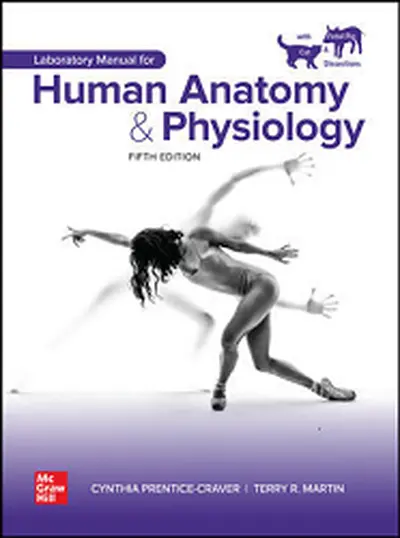
Orders within the United States are shipped via FedEx or UPS Ground. For shipments to locations outside of the U.S., only standard shipping is available. All shipping options assume the product is available and that processing an order takes 24 to 48 hours prior to shipping.
View PriceNote: Connect can only be used if assigned by your instructor.
Learn more about Connect >* The estimated amount of time this product will be on the market is based on a number of factors, including faculty input to instructional design and the prior revision cycle and updates to academic research-which typically results in a revision cycle ranging from every two to four years for this product. Pricing subject to change at any time.
Quick Actions (Only for Validated Instructor Accounts):
Request an Ebook Sample Contact a RepAuthors Cynthia Prentice-Craver and Terry Martin combine passion for and experience teaching human anatomy and physiology with a commitment to developing curricula that stimulates student curiosity and enthusiasm, which results in a laboratory manual with an innovative, hands-on approach. The Laboratory Manual for Human Anatomy & Physiology includes 63 laboratory exercises, three supplemental labs found online, six cat dissection labs, six fetal pig dissection labs, 46 Virtual Lab lessons, and 13 Physiology Interactive Lab Simulations (PhILS) lessons. Designed to work well with any anatomy and physiology text, this updated fifth edition of the lab manual incorporates learning outcomes and assessments to help students master important material. A clear, concise writing style facilitates more thorough understanding of lab exercises.
Fundamentals of Human Anatomy and Physiology
1 Scientific Method and Measurements
2 Body Organization, Membranes, and Terminology
3 Chemistry of Life
4 Care and Use of the Microscope
5 Cell Structure and Function
6 Movements Through Membranes
8 Epithelial Tissues
9 Connective Tissues
10 Muscle and Nervous Tissues
11 Integumentary System
12 Bone Structure and Classification
13 Organization of the Skeleton
15 Vertebral Column and Thoracic Cage
16 Pectoral Girdle and Upper Limb
17 Pelvic Girdle and Lower Limb
18 Fetal Skeleton
19 Joint Structure and Movements
20 Skeletal Muscle Structure and Function
21 Electromyography: BIOPAC Exercise
22 Muscles of the Head and Neck
23 Muscles of the Chest, Shoulder, and Upper Limb
24 Muscles of the Vertebral Column, Abdominal Wall, and Pelvic Floor
25 Muscles of the Hip and Lower Limb Laboratory
26 Surface Anatomy
27 Nervous Tissue and Nerves
28 Spinal Cord, Spinal Nerves, and Meninges
29 Reflex Arc and Reflexes
30 Brain and Cranial Nerves
31 Electroencephalography: BIOPAC Exercise
32 Dissection of the Sheep Brain
General and Special Senses
33 General Senses
34 Smell and Taste
35 Eye Structure
36 Visual Tests and Demonstrations
37 Ear and Hearing
38 Ear and Equilibrium
39 Endocrine Structure and Function
40 Diabetic Physiology
42 Blood Testing
43 Blood Typing
44 Heart Structure
45 Cardiac Cycle
46 Electrocardiography: BIOPAC Exercise
47 Blood Vessel Structure, Arteries, and Veins
48 Pulse Rate and Blood Pressure
49 Lymphatic System
50 Respiratory Organs
51 Breathing and Respiratory Volumes
52 Spirometry: BIOPAC Exercise
53 Control of Breathing
54 Digestive Organs
55 Action of a Digestive Enzyme
57 Urinary Organs
Reproductive Systems and Development
59 Male Reproductive System
60 Female Reproductive System
61 Meiosis, Fertilization, and Early Development
Cat Dissection Exercises
63 Cat Dissection: Musculature
64 Cat Dissection: Cardiovascular System
65 Cat Dissection: Respiratory System
66 Cat Dissection: Digestive System
67 Cat Dissection: Urinary System
68 Cat Dissection: Reproductive Systems
Fetal Pig Dissection Exercises
69 Fetal Pig Dissection: Musculature
70 Fetal Pig Dissection: Cardiovascular System
71 Fetal Pig Dissection: Respiratory System
72 Fetal Pig Dissection: Digestive System
73 Fetal Pig Dissection: Urinary System
74 Fetal Pig Dissection: Reproductive Systems
Cynthia Prentice-Craver
Cynthia Prentice-Craver has been teaching human anatomy and physiology for over twenty-eight years at Chemeketa Community College. Cynthia’s teaching experience both in grades 6–12 and in college, her passion for curriculum development, and her appetite for learning fuel her desire to write. Her M.S. in Curriculum and Instruction, B.S. in Exercise Science, and extended graduate course-work in biological sciences have been instrumental in achieving effective results in the online and on campus courses she teaches. Cynthia was a contributing author for the Martin Laboratory Manual for Human Anatomy & Physiology, Third Edition, and Hole’s Essentials of Human Anatomy & Physiology, Fourteenth Edition. She co-authored Hole’s Human Anatomy & Physiology, Sixteenth Edition, and the Martin Laboratory Manual for Human Anatomy & Physiology, Fourth and Fifth Editions, and authored the digital content for these laboratory manuals. Cynthia is a member of the Human Anatomy and Physiology Society (HAPS) and the Textbook & Academic Authors Association (TAA). Her professional experiences include serving as a program chair for eight years, developing curriculum, serving on various committees, and being a reviewer and advisor of textbooks and digital products. Beyond her professional pursuits, Cynthia’s passions include reading and listening to books, attending exercise classes, walking outdoors, attending concerts, traveling, and spending time with her family and friends.
Terry Martin
Creating accessible products is a priority for McGraw Hill. We make accessibility and adhering to WCAG AA guidelines a part of our day-to-day development efforts and product roadmaps.
For more information, visit our accessibility page, or contact us at accessibility@mheducation.com
Reduce course material costs for your students while still providing full access to everything they need to be successful. It isn't too good to be true - it's Inclusive Access.